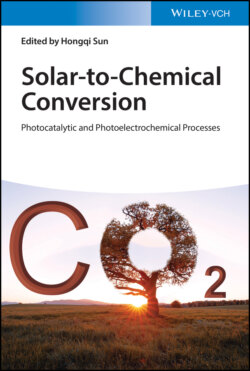Читать книгу Solar-to-Chemical Conversion - Группа авторов - Страница 22
2.4.1.5 C2 Hydrocarbons
ОглавлениеFrom the reaction procedure of CO2 photoreduction, the reductive electrons mainly react with the adsorbed carbon species into C1 products because these reactions can be more easily driven thermodynamically. On the other hand, more valuable hydrocarbons including ethane and ethanol are more desirable such that it is inevitable to proceed multistep reactions involving more complicated reaction mechanism. It is well known that a multistep reaction means decaying of reaction efficiency and increasing of by‐products. Therefore, selectivity is a key parameter for the production of C2 or higher hydrocarbons.
In general, there are two possible ways of CO2 reduction to C2H6, which is from hydrogenation of ethylene intermediate or dimerization of two CH3 adsorbates. Recently, Choi and his group introduced a thin Nafion layer on Pd‐deposited TiO2 nanoparticles that markedly enhances the photosynthetic conversion of CO2 to hydrocarbons (mainly CH4 and C2H6) in an aqueous suspension without any sacrificial electron donor under UV and solar irradiation conditions [57]. In this system, the Nafion layer functioned as a conductive and fixed layer to facilitate diffusion of protons onto the CO2 reduction sites and immobilize intermediates of CO2 reduction, which could help the serial electron transfers from the intermediate to the final product. The hybridized catalyst displays the CH4 and C2H6 production of 123 and 12 μmol gcat−1, which apparently inhibited H2 generation. Besides, Kulandaivalu et al. constructed a CQDs/Cu2O nanocomposite photocatalyst with good optical, physical, and chemical properties that was able to selectively reduce CO2 to C2H6 under visible‐light irradiation [58]. The improved photoactivity is the accumulated C2H6 of 101.83 μmol gcat−1 for six hours under continuous visible‐light illumination, while the pure Cu2O photocatalyst produces C2H6 of 66.73 μmol gcat−1 for the same reaction time. The findings present that no methane or ethylene is detected over bare Cu2O and CQDs/Cu2O hybrids, indicating that the dimerization of CH3 adsorbates is favorable in this system. The proposed step number of C2H6 production is eight, where both the photoinduced electrons and holes take part in the CO2 photoreduction and 3.5 molecules of O2 for each C2H6 molecular is released from water splitting process but no hydrogen is detected.
Apart from ethane, ethanol is also reported in the photoreduction of CO2 in the past [59]. Recently, Liu et al. reported visible‐light‐responsive photocatalyst BiVO4 for selective formation of ethanol under the condition of high‐intensity visible‐light irradiation [60]. It is known that the proton in water cannot capture the photogenerated electrons on BiVO4 to produce H2. In contrast, once CO2 molecule is adsorbed and changed to CO32−, the photogenerated electrons can react with CO32− likely and give rise to methanol after protonation. Furthermore, under intense irradiation, a large number of C1 intermediate species are anchored on the surface of BiVO4, which will facilitate dimerization of C1 intermediate species to form ethanol. Based on this strategy, Peng and coworkers took advantage of graphitic carbon nitride with high CB position for achieving selectively photocatalytic reduction of CO2 under visible‐light irradiation [61]. It was found that the starting materials of graphitic C3N4 have significant influence on the activity and selectivity of CO2 reduction. Once graphitic carbon nitride was fabricated by using urea (denoted as u‐g‐C3N4) that possessed large surface area with mesoporous nanostructure, the reduced products of CO2 were a mixture of CH3OH and C2H5OH in the presence of NaOH (1.0 M), where the yields were 6.28 and 4.51 μmol gcat−1 h−1, respectively. Compared with u‐g‐C3N4, the sample prepared by using melamine (denoted as m‐g‐C3N4) mainly catalyzed CO2 to C2H5OH under the same conditions, where the yield of C2H5OH was 3.64 μmol gcat−1 h−1. Meanwhile, high concentration O2 and trace H2 were detected in two samples, inferring that photoexcited holes at VB of C3N4 can be efficiently formed from water splitting and the corresponding electrons took part in the conversion of CO2 with H+ into alcohols. Moreover, by comparing u‐g‐C3N4 with m‐g‐C3N4, it shows that larger surface area, smaller crystal size, and lower crystallinity may be the main reasons for the apparent difference in selective formation of CH3OH and C2H5OH in the present system. Owing to the nonporous structure of m‐g‐C3N4, the fast exchange of the formed ·OCH3 or CH3OH may be suppressed, thereby in turn benefiting the dimerization to produce C2H5OH in the present CO2/NaOH system.
In addition, Pastrana‐Martínez et al. prepared a graphene derivative–TiO2 composites for photocatalytic water reduction of CO2 into renewable fuels under UV–vis light irradiation [62]. Meanwhile, the findings present that the pH of solution has significant influence toward selective ethanol formation. The prepared GO/TiO2 composite exhibited superior photocatalytic activity for EtOH production (144.7 μmol gcat−1 h−1) at pH 11.0 and for MeOH production (47.0 μmol gcat−1 h−1) at pH 4.0. It is found that the yield of C2 hydrocarbons is much lower than that of C1 products due to the demand of more electrons and complicated reaction mechanism, which cannot be varied. Therefore, it is more feasible that the long‐chain hydrocarbons are formed as secondary products over photocatalysts that can realize efficient C1–C2 conversion in the future.
